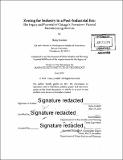Zoning for industry in a post-industrial era : the legacy and potential of Chicago's downtown planned manufacturing districts
Author(s)
Jordahl, Haley
DownloadFull printable version (19.23Mb)
Alternative title
Legacy and potential of Chicago's downtown PMDs
Other Contributors
Massachusetts Institute of Technology. Department of Urban Studies and Planning.
Advisor
Karl Seidman.
Terms of use
Metadata
Show full item recordAbstract
In 1988, Chicago established a unique zoning mechanism intended to preserve manufacturing space in its downtown: the planned manufacturing district (PMD), which protects production-oriented land use in gentrifying neighborhoods where industrial buildings are at risk of conversion to housing or commercial space. The PMDs were rooted in an effort to retain manufacturing business, and the employment they supported, amidst structural deindustrialization and downtown gentrification. In the 28 years since, Chicago's downtown development pattern has followed a decidedly post-industrial trajectory: the City has pursued an economic development strategy focused on service-sector growth, and industrial employment in the Loop has declined precipitously. Fifteen PMDs continue to exist, however, and half are concentrated in the neighborhoods that ring the downtown. In 2014, Chicago's second-oldest steel mill, Finkl Steel, relocated its production facility from Lincoln Park, a high-income residential neighborhood north of the Loop, leaving a 40-acre parcel vacant and creating the largest downtown redevelopment opportunity in 30 years. The opening of the FInkI Steel site, coupled with a thriving tech sector eager to convert industrial space to office use, has sparked renewed debate over the value and purpose of industrial areas in downtown Chicago. This spring, the City launched a public review process intended to explore potential mixed-use development in its downtown PMDs. Chicago's downtown PMDs have not yet been examined to understand how, or whether, they continue to hold the high-value industrial work they were intended to preserve. This thesis uses business and employment data, coupled with a series of in-person stakeholder interviews, to illustrate the economic and employment dynamics of three downtown PMDs between 2005 and 2013. Though the districts have lost industrial employment more rapidly than the City of Chicago, they are swiftly adding work in non-industrial sectors. This thesis contends that the flexible structure of Chicago's PMDs has allowed them to serve as spaces for employment growth; however, as a land use tool, industrial zoning does not have the capacity or teeth to ensure that emerging opportunities for work are high-value. "It is becoming a recognized fact that the power, growth, and advancement of a city is limited only by the measure of united civic interest of its people. The stronger and more vital the community spirit, the greater and more influential a city. It is this spirit which gives Chicago its great world distinction." Wacker's Manual of the Plan for Chicago, 1916 "The antimony of neighborhood versus downtown - a long-standing, urban grass-roots metaphor - was transformed in Chicago and elsewhere in the 1980s to portray a new set of development choices: manufacturing versus the service economy; blue-collar jobs versus low-wage McJobs; job generation versus real estate development; industrial expansion versus downtown growth; credit-starved neighborhoods versus the growth of the finance industry; targeted local hiring versus regional business climate; and minority / female businesses versus efficiency." "Spatial Change and Social Justice: Alternative Economic Development in Chicago," Robert Giloth & Robert Mier "At a time when jobs and economic opportunity are desperately needed across all neighborhoods, it pays to shine a bright light on the planned manufacturing district and the city's industrial retention policies and plans, and to ultimately ask the question of who benefits from these industrial land use decisions." "Pull the plug? No way. Let's power up the Clybourn industrial corridor," Mike Holzer.
Description
Thesis: M.C.P., Massachusetts Institute of Technology, Department of Urban Studies and Planning, 2016. Cataloged from PDF version of thesis. Includes bibliographical references (pages 116-121).
Date issued
2016Department
Massachusetts Institute of Technology. Department of Urban Studies and PlanningPublisher
Massachusetts Institute of Technology
Keywords
Urban Studies and Planning.